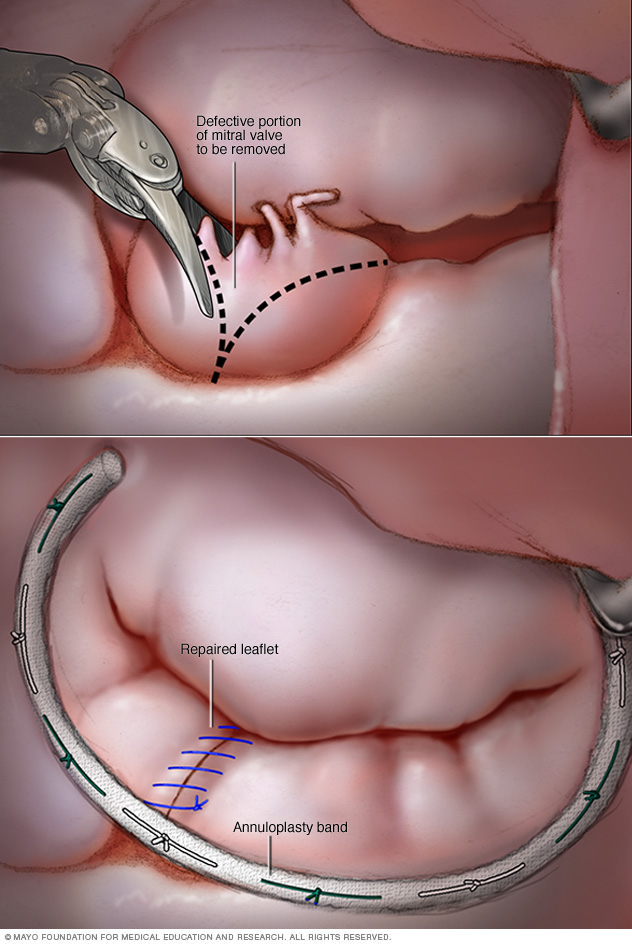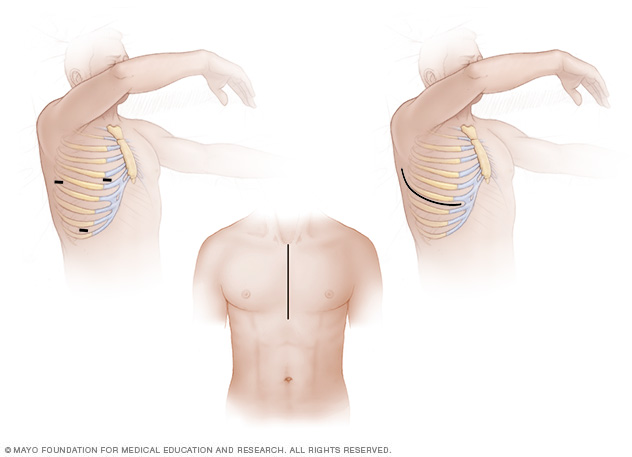Mitral valve repair and mitral valve replacement
Overview
Mitral valve repair and mitral valve replacement are types of heart surgery to fix or replace a leaky or narrowed mitral valve. The mitral valve is one of four heart valves that control blood flow in the heart. It's located between the upper and lower left heart chambers.
Mitral valve repair and mitral valve replacement may be done as an open-heart surgery or as a minimally invasive surgery. The method used depends on how severe the mitral valve disease is and if it's getting worse.
Surgeons usually recommend mitral valve repair instead of replacement, when possible. It keeps the existing heart valve and can help save heart function.

In robotic mitral valve repair surgery, a doctor removes the part of the mitral valve that doesn't close properly, as shown in the top image. Stitches are used to connect the valve edges together. A ring, called an annuloplasty band, is used to tighten the width of the valve, as shown on the bottom image.
Why it's done
Mitral valve repair or replacement is done to treat a damaged or diseased mitral valve. The mitral valve is between the two left heart chambers. The valve has flaps, also called leaflets, that open and close to let blood pass through.
Your healthcare team may suggest mitral valve surgery if you have:
- Mitral valve regurgitation. The valve flaps don't close tightly. This lets blood leak backward. Mitral valve repair surgery is recommended if you have severe mitral valve regurgitation symptoms.
- Mitral valve stenosis. The valve flaps become thick or stiff. Sometimes they stick together. The valve becomes narrowed. So less blood can flow through the valve. Mitral valve surgery may be done if the stenosis is severe and causing shortness of breath or other symptoms.
Sometimes, mitral valve surgery may be done even if you don't have symptoms. For example, if you need heart surgery for another condition, surgeons might do mitral valve surgery at the same time. Research suggests that doing valve surgery in some people with severe mitral valve regurgitation who don't have symptoms improves long-term outcomes.
Mitral valve repair also may be done to avoid complications that can occur with mitral valve replacement. Complications depend on the type of valve used. They may include blood clots and valve failure.
Risks
Possible risks of mitral valve repair and mitral valve replacement surgery include:
- Bleeding.
- Blood clots.
- Failure of the replacement valve.
- Irregular heartbeats, called arrhythmias.
- Infection.
- Stroke.
How you prepare
To prepare for mitral valve repair or replacement, you have tests to get more details about your heart. For example, you usually have an ultrasound of the heart, also called an echocardiogram.
Your care team tells you what to expect before, during and after surgery.
Talk to your loved ones about your surgery and hospital stay. Tell them what help you may need when you return home.
Food and medications
Before you have mitral valve surgery, talk to your care team about:
- The medicines you take. Ask whether you can take them before your surgery.
- Allergies or reactions you've had to medicines.
- When you should stop eating or drinking before surgery.
Clothing and personal items
Your care team may recommend that you bring several items to the hospital, including:
- A list of your medicines.
- Eyeglasses, hearing aids or dentures.
- Personal care items, such as a brush, a comb, a shaving kit and a toothbrush.
- Loose, comfortable clothing.
- A copy of your advance directive. This is a legal document. It includes instructions about the kinds of treatments you want or don't want in case you become unable to express your wishes.
- Items that help you relax, such as portable music players or books.
During mitral valve repair or replacement, do not wear:
- Contact lenses.
- Dentures.
- Eyeglasses.
- Jewelry.
- Nail polish.
What you can expect
Surgery to repair or replace the mitral valve is done at a hospital by a heart surgeon, called a cardiovascular surgeon.
If you also need heart surgery for another condition, the surgeon may do both surgeries at the same time.
Before
Before mitral valve surgery starts, a member of your care team may shave any body hair from your chest area. A special soap is used to wash your skin. The soap kills germs and helps prevent infection.
You get medicines to put you in a sleep-like state during the surgery. This is called general anesthesia. You are connected to a heart-lung bypass machine, which keeps blood moving through the body during the surgery.
During
What happens during mitral valve repair and replacement depends on the specific method used. Mitral valve surgery can be done in different ways.
- Open-heart surgery. The surgeon makes a cut, called an incision, through the middle of the chest to reach the heart.
- Minimally invasive heart surgery. This surgery uses much smaller cuts than those used in open-heart surgery. It may result in a shorter hospital stay, quicker recovery and less pain than open-heart surgery. Minimally invasive heart valve surgery generally should be done at medical centers with doctors experienced in performing such surgeries.
- Robot-assisted heart surgery. This is a type of minimally invasive surgery. A surgeon uses robotic arms to perform the same movements used in open-heart surgery.
- Catheter-based procedure. Some heart valve repairs are done using a long, thin tube called a catheter and clips, plugs or other devices. A surgeon can pass tools through the catheter to repair or replace the mitral valve. Transcatheter mitral replacement is an example of a catheter-based procedure.
Mitral valve repair
Heart doctors recommend mitral valve repair when possible. During mitral valve repair surgery, a surgeon might:
- Patch holes in the mitral valve.
- Reconnect the valve flaps.
- Remove extra tissue from the valve so that the flaps can close tightly.
- Replace or remove pieces of tissue called cords that are diseased and no longer support the valve.
- Separate valve flaps that have connected.
- Tighten or reinforce the ring around the valve, called the annulus.
Types of mitral valve repair include:
- Annuloplasty. Surgeons tighten or reinforce the ring around the valve. Annuloplasty may be done alone or with other methods to repair a heart valve.
- Valvuloplasty. Also called balloon valvotomy, this treatment is used to repair a mitral valve with a narrowed opening. The doctor inserts a catheter with a balloon on the tip into an artery in the arm or groin and guides it to the mitral valve. The balloon is inflated. This makes the mitral valve opening larger. The balloon is deflated. The catheter and balloon are removed.
- Mitral valve clip. A surgeon guides a catheter with a clip on its end to the mitral valve through an artery in the groin. The clip is used to fix a torn or leaky mitral valve leaflet. This treatment may be recommended if you have severe mitral valve regurgitation and you cannot have other types of mitral valve surgery.
Mitral valve replacement
During mitral valve replacement, the heart surgeon removes the mitral valve. It's replaced with a mechanical valve or a valve made from cow, pig or human heart tissue. A valve made from living tissue is called a biological tissue valve.
Sometimes, the surgeon uses a thin flexible tube called a catheter to insert a new valve into a biological tissue valve that no longer works well. This is called a valve-in-valve procedure, also called a transcatheter mitral valve-in-valve procedure.
After
After mitral valve repair or replacement surgery, you usually spend a few days in the hospital. How long you stay in the hospital depends on your specific condition and surgery.
During your hospital stay, your care team frequently checks your blood pressure, breathing and heart rate. You may get:
- Fluids and medicines through an IV.
- Oxygen.
- Pain medicine.
You might have tubes to drain urine from your bladder and fluid and blood from your chest.
In the hospital, your care team helps you:
- Slowly increase your activity.
- Take longer and longer walks in the hospital.
- Do breathing exercises.
Your care team gives you instructions to follow during recovery, such as:
- How to care for your surgical cuts.
- What medicines you should take and when.
- How to manage pain and other side effects.
- How to recognize the symptoms of infection and when to call your care team.
After mitral valve repair or mitral valve replacement, your healthcare professional tells you when you can safely return to daily activities, such as working, driving and exercise.

In minimally invasive heart surgery, surgeons access the heart through small cuts on the right side of the chest, as shown in the top two images. In open-heart surgery, surgeons make a larger incision in the midline of the chest, as shown in the bottom image.

In robotic mitral valve repair surgery, a doctor removes the part of the mitral valve that doesn't close properly, as shown in the top image. Stitches are used to connect the valve edges together. A ring, called an annuloplasty band, is used to tighten the width of the valve, as shown on the bottom image.
Results
Mitral valve repair and replacement surgery may help reduce valve disease symptoms. The treatment also may improve quality of life.
If you had mitral valve replacement with a mechanical valve, you need to take blood thinners for life to prevent blood clots. Biological tissue valves break down over time and usually need to be replaced. Mechanical valves usually do not wear out over time.
Regular health checkups are needed to make sure the new or repaired valve is working properly. Your healthcare professional may recommend a program of education and exercise to help you improve your health and recover after heart valve surgery. This type of program is called cardiac rehabilitation, commonly called cardiac rehab.
Following a healthy lifestyle is important to heart health before and after mitral valve repair or mitral valve replacement. A healthy lifestyle includes:
- Not smoking or using tobacco.
- Getting regular exercise.
- Maintaining a healthy weight.
- Eating nutritious foods and limiting salt and saturated fats.
- Managing stress.
- Controlling blood pressure, cholesterol and blood sugar.
- Getting 7 to 8 hours of sleep daily.
Last Updated Apr 16, 2024
© 2024 Mayo Foundation for Medical Education and Research (MFMER). All rights reserved. Terms of Use





